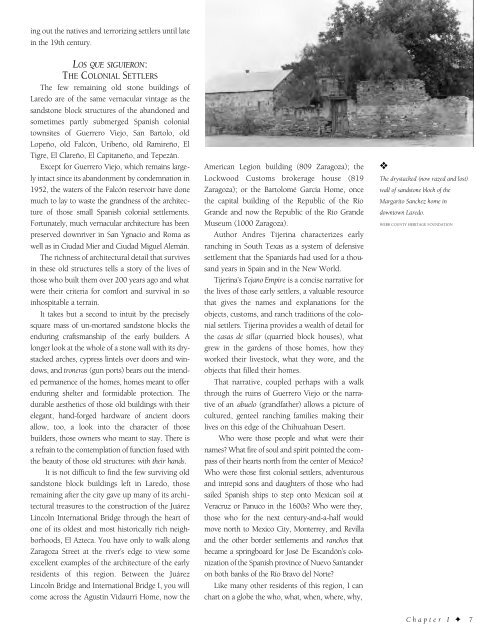Historic Laredo
An illustrated history of the city of Laredo and the Webb County area, paired with the histories of companies, families and organizations that make the region great.
An illustrated history of the city of Laredo and the Webb County area, paired with the histories of companies, families and organizations that make the region great.
Create successful ePaper yourself
Turn your PDF publications into a flip-book with our unique Google optimized e-Paper software.
ing out the natives and terrorizing settlers until late<br />
in the 19th century.<br />
LOS QUE SIGUIERON:<br />
THE COLONIAL SETTLERS<br />
The few remaining old stone buildings of<br />
<strong>Laredo</strong> are of the same vernacular vintage as the<br />
sandstone block structures of the abandoned and<br />
sometimes partly submerged Spanish colonial<br />
townsites of Guerrero Viejo, San Bartolo, old<br />
Lopeño, old Falcón, Uribeño, old Ramireño, El<br />
Tigre, El Clareño, El Capitaneño, and Tepezán.<br />
Except for Guerrero Viejo, which remains largely<br />
intact since its abandonment by condemnation in<br />
1952, the waters of the Falcón reservoir have done<br />
much to lay to waste the grandness of the architecture<br />
of those small Spanish colonial settlements.<br />
Fortunately, much vernacular architecture has been<br />
preserved downriver in San Ygnacio and Roma as<br />
well as in Ciudad Mier and Ciudad Miguel Alemán.<br />
The richness of architectural detail that survives<br />
in these old structures tells a story of the lives of<br />
those who built them over 200 years ago and what<br />
were their criteria for comfort and survival in so<br />
inhospitable a terrain.<br />
It takes but a second to intuit by the precisely<br />
square mass of un-mortared sandstone blocks the<br />
enduring craftsmanship of the early builders. A<br />
longer look at the whole of a stone wall with its drystacked<br />
arches, cypress lintels over doors and windows,<br />
and troneras (gun ports) bears out the intended<br />
permanence of the homes, homes meant to offer<br />
enduring shelter and formidable protection. The<br />
durable aesthetics of those old buildings with their<br />
elegant, hand-forged hardware of ancient doors<br />
allow, too, a look into the character of those<br />
builders, those owners who meant to stay. There is<br />
a refrain to the contemplation of function fused with<br />
the beauty of those old structures: with their hands.<br />
It is not difficult to find the few surviving old<br />
sandstone block buildings left in <strong>Laredo</strong>, those<br />
remaining after the city gave up many of its architectural<br />
treasures to the construction of the Juárez<br />
Lincoln International Bridge through the heart of<br />
one of its oldest and most historically rich neighborhoods,<br />
El Azteca. You have only to walk along<br />
Zaragoza Street at the river’s edge to view some<br />
excellent examples of the architecture of the early<br />
residents of this region. Between the Juárez<br />
Lincoln Bridge and International Bridge I, you will<br />
come across the Agustín Vidaurri Home, now the<br />
American Legion building (809 Zaragoza); the<br />
Lockwood Customs brokerage house (819<br />
Zaragoza); or the Bartolomé García Home, once<br />
the capital building of the Republic of the Río<br />
Grande and now the Republic of the Río Grande<br />
Museum (1000 Zaragoza).<br />
Author Andres Tijerina characterizes early<br />
ranching in South Texas as a system of defensive<br />
settlement that the Spaniards had used for a thousand<br />
years in Spain and in the New World.<br />
Tijerina’s Tejano Empire is a concise narrative for<br />
the lives of those early settlers, a valuable resource<br />
that gives the names and explanations for the<br />
objects, customs, and ranch traditions of the colonial<br />
settlers. Tijerina provides a wealth of detail for<br />
the casas de sillar (quarried block houses), what<br />
grew in the gardens of those homes, how they<br />
worked their livestock, what they wore, and the<br />
objects that filled their homes.<br />
That narrative, coupled perhaps with a walk<br />
through the ruins of Guerrero Viejo or the narrative<br />
of an abuelo (grandfather) allows a picture of<br />
cultured, genteel ranching families making their<br />
lives on this edge of the Chihuahuan Desert.<br />
Who were those people and what were their<br />
names? What fire of soul and spirit pointed the compass<br />
of their hearts north from the center of Mexico?<br />
Who were those first colonial settlers, adventurous<br />
and intrepid sons and daughters of those who had<br />
sailed Spanish ships to step onto Mexican soil at<br />
Veracruz or Panuco in the 1600s? Who were they,<br />
those who for the next century-and-a-half would<br />
move north to Mexico City, Monterrey, and Revilla<br />
and the other border settlements and ranchos that<br />
became a springboard for José De Escandón’s colonization<br />
of the Spanish province of Nuevo Santander<br />
on both banks of the Río Bravo del Norte?<br />
Like many other residents of this region, I can<br />
chart on a globe the who, what, when, where, why,<br />
❖<br />
The drystacked (now razed and lost)<br />
wall of sandstone block of the<br />
Margarito Sanchez home in<br />
downtown <strong>Laredo</strong>.<br />
WEBB COUNTY HERITAGE FOUNDATION<br />
Chapter I ✦ 7
















